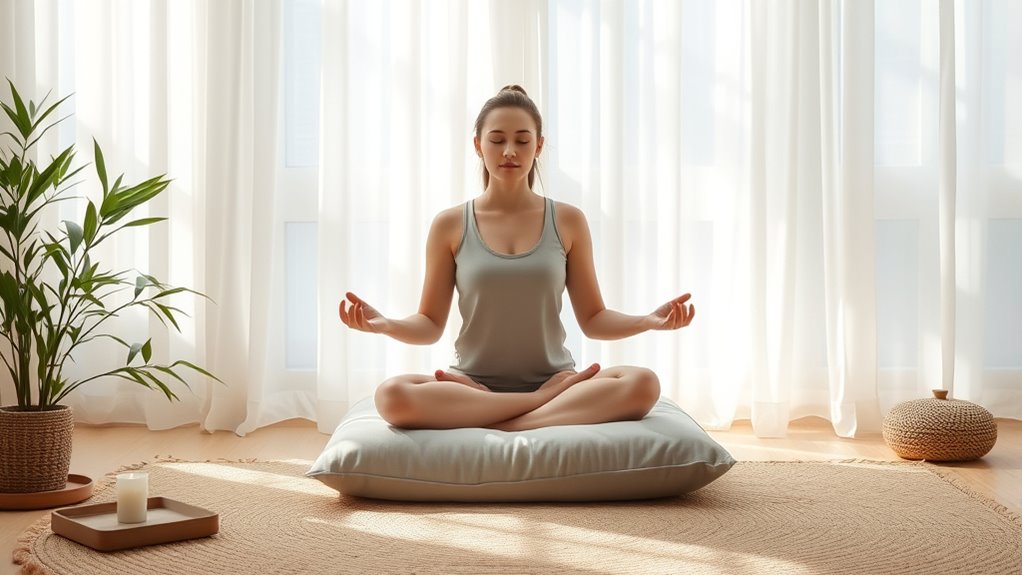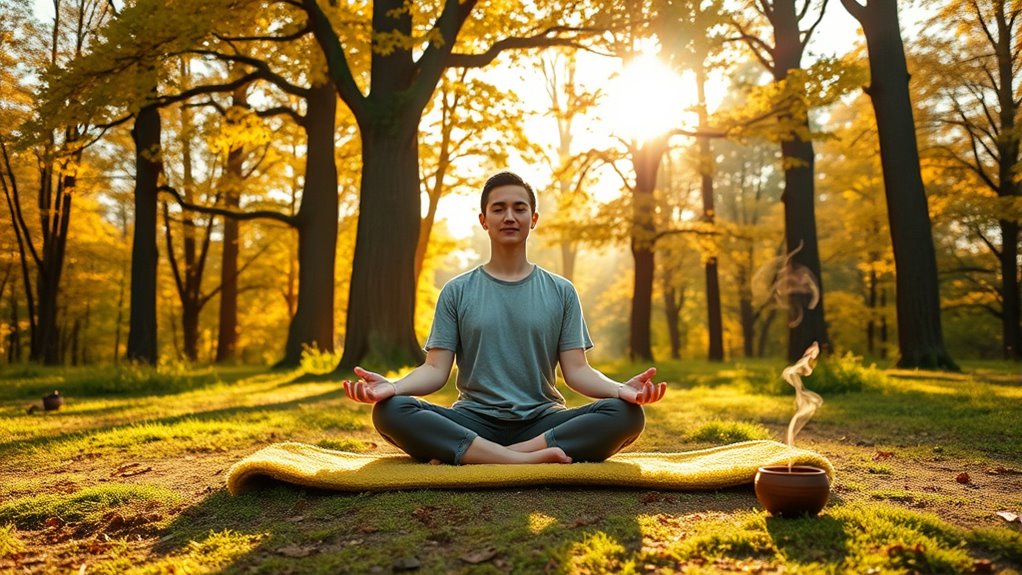To cultivate inner peace as a beginner, start with simple mindfulness practices like focusing on your breath or bodily sensations during short, daily sessions. Incorporate easy breathing exercises, such as inhaling and exhaling slowly for a few counts, to help calm your mind. Stick to a routine, even just 5-10 minutes each day, and observe your thoughts without judgment. As you continue, you’ll discover how these gentle habits can bring greater calm and clarity into your life.
Key Takeaways
- Start with simple mindfulness techniques focusing on breath or sensations to build awareness gradually.
- Practice short, consistent sessions of 5-10 minutes daily to develop a sustainable routine.
- Use breathing exercises like inhaling and exhaling slowly to promote calmness and reduce stress.
- Observe thoughts non-judgmentally to cultivate gentle awareness and present-moment focus.
- Incorporate meditation into daily life for mental clarity, relaxation, and long-term inner peace.

If you’re new to meditation, starting can feel overwhelming, but it’s simpler than you might think. The key is to begin with simple practices that help you gradually develop awareness and calmness. One effective way to do this is through mindfulness techniques. These involve paying close attention to your present moment without judgment. You can start by focusing on your breath, sensations in your body, or even sounds around you. The goal isn’t to empty your mind but to observe your thoughts as they come and go, cultivating a gentle awareness of the here and now.
Breathing exercises are a cornerstone of meditation for beginners because they’re easy to learn and immediately calming. For example, try inhaling slowly through your nose for a count of four, holding your breath for a count of four, then exhaling gently through your mouth for another four counts. Repeat this cycle several times, paying close attention to the rhythm of your breath. This simple technique helps anchor your attention and reduces stress, making it easier to stay present. As you practice, you’ll notice your mind settling, and your body relaxing. Over time, these breathing exercises become a quick way to reset your mood or find focus during a busy day.
When you incorporate mindfulness techniques and breathing exercises into your routine, consistency is important. You don’t need long sessions; even five to ten minutes daily can bring noticeable benefits. Find a quiet spot where you won’t be disturbed, sit comfortably, and set an intention to be present. As you breathe or observe your surroundings, try to notice the small details—like the sensation of air entering your nostrils or the feeling of your feet on the ground. This helps develop a habit of awareness that spills over into other parts of your life, enhancing mental clarity, reducing anxiety and increasing overall well-being.
Frequently Asked Questions
How Long Should I Meditate as a Beginner?
As a beginner, start with a meditation duration of 5 to 10 minutes daily. Following beginner guidelines, gradually increase your meditation time as you become more comfortable and focused. Don’t push yourself too hard at first; consistency matters more than length. Over time, you can extend your sessions to 15 or 20 minutes. Remember, regular practice helps cultivate inner peace and builds a sustainable meditation habit.
Can Meditation Help With Stress and Anxiety?
Yes, meditation can help reduce stress and anxiety. When you practice mindfulness techniques and breathing exercises, you activate your body’s relaxation response, calming your mind. By focusing on your breath and staying present, you can break free from worries and racing thoughts. Regular meditation makes it easier to manage stress, improve mood, and feel more centered. So, start with just a few minutes daily to experience these calming benefits.
Is It Necessary to Sit in a Specific Posture?
You don’t need a specific posture to meditate, but maintaining good posture helps with posture importance and sitting comfort. Find a position that keeps your spine straight and allows you to relax. You can sit on a chair, cushion, or floor—what matters most is feeling stable and comfortable. This way, your focus stays on your breath or thoughts, not on physical discomfort, making your meditation more effective.
What if My Mind Keeps Wandering During Meditation?
If your mind keeps wandering, don’t worry—it’s normal and part of the process. When concentration challenges arise, gently bring your focus back to your breath or chosen point of attention without judgment. Over time, this practice strengthens your focus, making it easier to stay present. Remember, patience is key. With consistent effort, you’ll notice your mind wandering less and your meditation becoming more peaceful and centered.
Are There Any Apps or Tools Recommended for Beginners?
They say, “A journey of a thousand miles begins with a single step,” so start small. For beginners, guided meditation and mindfulness apps like Headspace, Calm, or Insight Timer are great tools. They offer easy-to-follow sessions that help you stay focused and build a habit. These apps make meditation accessible, helping you cultivate inner peace and mindfulness even if your mind wanders. Give them a try!
Conclusion
By practicing these meditation techniques, you’ll open a level of inner peace so powerful, it’s like discovering a secret portal to tranquility that changes your life forever. With each breath, you’ll feel stress melting away faster than ice cream on a hot summer day, leaving you calmer than a sleeping kitten. Keep at it, and soon you’ll wield the mind-calming superpowers of a Zen master, transforming every moment into pure bliss. Your peaceful kingdom awaits—dive in now!











